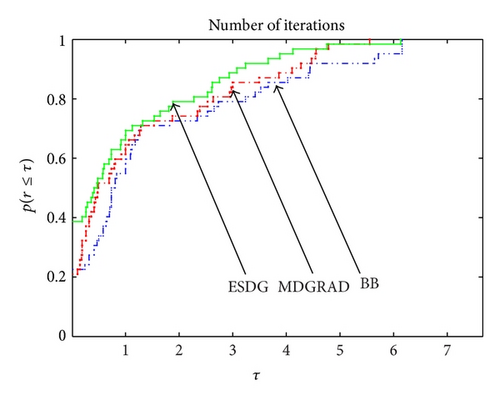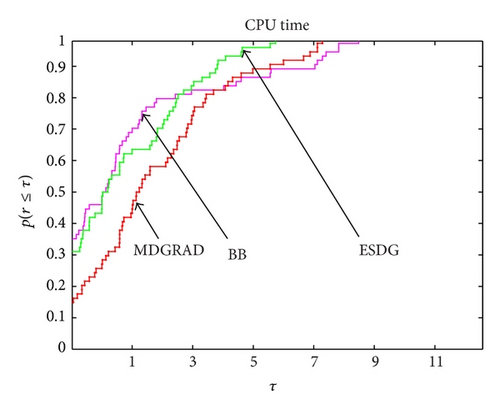Scaled Diagonal Gradient-Type Method with Extra Update for Large-Scale Unconstrained Optimization
Abstract
We present a new gradient method that uses scaling and extra updating within the diagonal updating for solving unconstrained optimization problem. The new method is in the frame of Barzilai and Borwein (BB) method, except that the Hessian matrix is approximated by a diagonal matrix rather than the multiple of identity matrix in the BB method. The main idea is to design a new diagonal updating scheme that incorporates scaling to instantly reduce the large eigenvalues of diagonal approximation and otherwise employs extra updates to increase small eigenvalues. These approaches give us a rapid control in the eigenvalues of the updating matrix and thus improve stepwise convergence. We show that our method is globally convergent. The effectiveness of the method is evaluated by means of numerical comparison with the BB method and its variant.
1. Introduction
Since that, the study of new effective methods in the frame of BB-like gradient methods becomes an interesting research topic for a wide range of mathematical programming; for example, see [2–10]. However, it is well known that BB method cannot guarantee a descent in the objective function at each iteration and the extent of the nonmonotonicity depends in some way on the size of the condition number of objective function [11]. Therefore, the performance of BB method is greatly influenced by the condition of the problem (particularly, condition number of the Hessian matrix). Some new fixed stepsizes gradient-type methods of BB kind are proposed by [12–16] to overcome these difficulties. In contrast with the BB approach in which the stepsize is computed by means of a simple approximation of the Hessian in the form of scalar multiple of identity, these proposed methods consider approximation of the Hessian and its inverse in diagonal matrix form based on the weak secant equation and quasi-cauchy relation, respectively (for more details see [15, 16]). Though these diagonal updating methods are efficient, their performance can be greatly affected by solving ill-conditioned problems. Thus, there is room for improve on the quality of the diagonal updates formulation. Since methods as described in [15, 16] have useful theoretical and numerical properties, it is desirable to derive a new and more efficient updating frame for general functions. Therefore our aim is to improve the quality of diagonal updating when it is poor in approximating Hessian.
This paper is organized as follows. In the next section, we describe our motivation and propose our new-gradient type method. The global convergence of the method under mild assumption will be established in Section 3. Numerical evidence of the vast improvements due to the new approach is given in Section 4. Finally, conclusion is made in the last section.
2. Scaling and Extra Updating
Note that when , the resulting Bk+1 is not necessarily positive definite and it is not appropriate for use within a quasi-Newton-based algorithm. Thus, it is desirable to propose a technique to measure the quality of Bk in terms of its Rayleigh quotient and try to find a way to improve “poor” quality Bk before calculating Bk+1. For this purpose, it will be useful to propose, at first quality a criterion to distinguish between poor, and acceptable quality of Bk.
An advantage of using (17) is that the positive definiteness of Bk+1 can be guaranteed in all iterations. This property is not exhibited in the other diagonal updating formula such as those in [15, 16]. Note that there is no extra storage required to impose our strategy and the cost of computing is also not increased significantly throughout the entire iteration. Now we can state the steps of our new diagonal-gradient method algorithm with the safeguarding strategy for monotonicity as follows.
2.1. ESDG Algorithm
Step 1. Choose an initial point x0 ∈ Rn and a positive definite matrix B0 = I. Let θ ∈ (1,2). Set k : = 0.
Step 2. Compute gk. If ∥gk∥ ≤ ϵ, stop.
Step 3. If k = 0, set x1 = x0 − g0/∥g0∥.
Step 4. Compute , and calculate αk > 0 such that the following condition holds: where and σ ∈ (0,1) is a given constant.
Step 5. If k ≥ 1, let and compute ρk and γk by (11) and (15), respectively. If ρk < θ then update Bk+1 by (16).
Step 6. If ρk ≥ θ then compute and by (12), (13), respectively, and then update as defined Bk+1 (14).
Step 7. Set k : = k + 1, and return to Step 2.
In Step 4, we employ the nonmonotone line search of [19, 20] to ensure the convergence of the algorithm. However, some other line search strategies may also be used.
3. Convergence Analysis
This section is devoted to study the convergence behavior of ESDG method. We will establish the convergence of the ESDG algorithm when applied to the minimization of a strictly convex function. To begin, we give the convergence result, which is due to Grippo et al. [21] for the step generated by the nonmonotone line search algorithm. Here and elsewhere, ∥·∥ denotes the Euclidean norm.
Theorem 1. Assume that f is a strictly convex function and its gradient g satisfies the Lipschitz condition. Suppose that the nonmonotone line search algorithm is employed in a case that the steplength, αk, satisfies
To prove that the ESDG algorithm is globally convergent, it is sufficient to show that the sequence {∥Bk∥} generated by (17) is bounded both above and below, for all finite k so that its associated search direction satisfies condition (19). Since Bk is diagonal, it is enough to show that each element of Bk, say , i = 1, …, n, is bounded above and below by some positive constants. The following theorem gives the boundedness of {∥Bk∥}.
Theorem 2. Assume that f is strictly convex function where there exist positive constants m and M such that
Proof. Let be the ith element of Bk. Suppose that B0 is chosen such that where ω1, ω2 are some positive constants. It follows from (17) and the definition of γ in (15) that we have
Case 2. When ρ0 > 1: from (3), we have
4. Numerical Results
In this section we present the results of numerical investigation for ESDG method on different test problems. We also compare the performance of our new method with that of the BB method and that of MDGRAD method which is implemented using SMDQN of [22] with a same nonmonotone strategy as the ESDG method. Our experiments are performed on a set of 20 nonlinear unconstrained problems with dimensions ranging from 10 to 104 (Table 1).
| Problem | References |
|---|---|
| Extended Freudenstein and Roth, Extended Trigonometric, | |
| Broyden Tridiagonal, Extended Beale, Generalized Rosenbrock, | Moré et al. [24] |
| Extended Tridiagonal 2, Extended Himmelblau, Raydan 2, EG2, | |
| Extended Three Exponential Terms, Raydan 1, Generalized PSC1, | |
| Quadratic QF2, Generalized Tridiagonal 1, Perturbed Quadratic, | |
| Diagonal 2, Diagonal 3, Diagonal 5, Almost perturbed Quadratic, | |
| Hager, diagonal 4 | Andrei [23] |
These test problems are taken from [23, 24]. The codes are developed with Matlab 7.0. All runs are performed on a PC with Core Duo CPU. For each test, the termination condition is ∥g(xk)∥ ≤ 10−4. The maximum number of iterations is set to 1000.
Figures 1 and 2 show the efficiency of ESDG method when compared to MDGRAD and BB methods. Note that ESDG method increases the efficiency of Hessian approximation devoid of increasing the number of storages. Figure 2 also shows the implementation of the ESDG method with BB and MDGRAD methods using the CPU time as a measure. This figure shows that ESDG method is again faster than MDGRAD method in most problems and requires reasonable time to solve large-scale problems when compares to the BB method. Finally, we can conclude that our experimental comparisons indicate that our extension is very beneficial to the performance.


5. Conclusion
We have presented a new diagonal gradient method for unconstrained optimization. Numerical study of the proposed method when compared with BB and MDGRAD methods is also performed. Based on our numerical experiments, we can conclude that ESDG method is significantly preferable compared to the BB and MDGRAD methods. Particularly, the ESDG method is proven to be a good option for large-scale problems when high-memory locations are required. In view of the remarkable performance of ESDG method, globally converged and with only O(n) storage, we can expect that our proposed method would be useful for unconstrained large-scale optimization problems.




